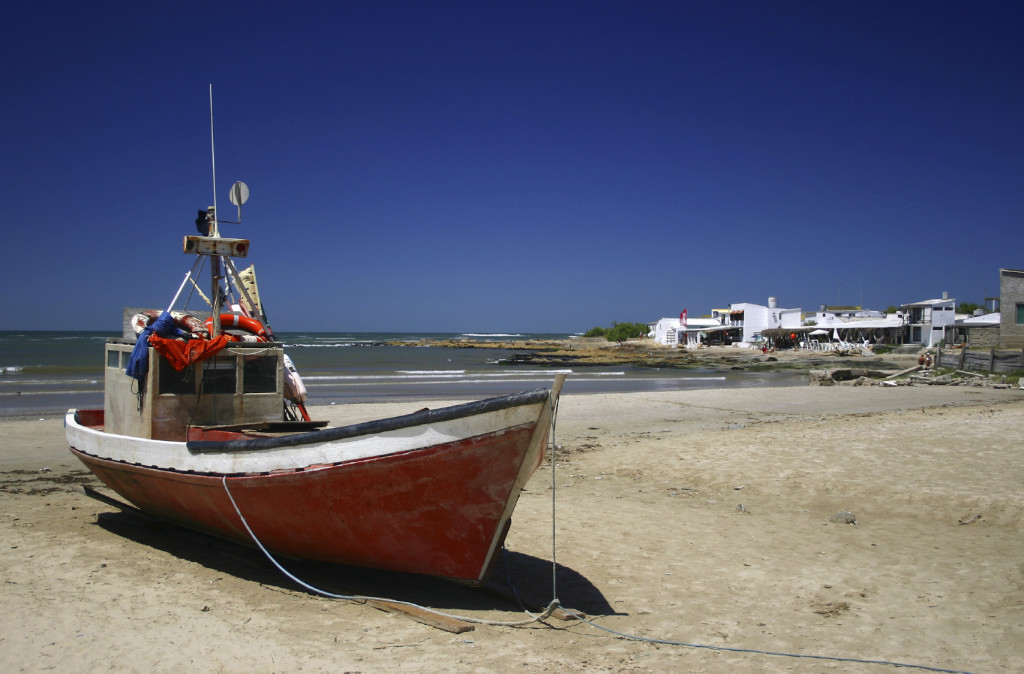If you would like to see more of the country but do not have much time, a weekend trip is a perfect way to explore Uruguay. The following places are easily accessible by bus in just a few hours.
- Estancias (Farmhouses): Not far from the city of Montevideo you can find areas of open fields to experience the quiet country life and enjoy the various attractions of rural tourism in a farm stay. You can spend a long weekend relaxing and reviving yourself with fresh rural air. More active visitors can enjoy swimming, horseback riding, hiking, as well as meals and typical local offerings (eg, the traditional asado).
- Regions
Maldonado
Apart from its biggest star, the city Punta del Este, other places to visit are:
Punta Ballena
Punta Ballena is a landform south of Punta del Este, which extends some way along the River Plate, and is a natural boundary between the Bay of Maldonado and Portezuelo. Here the natural beauty of the view over the cove, in which various natural harbor water sports are performed, is combined with the famous Casa-Taller-Casapueblo Gallery, designed by artist Carlos Páez Vilaró.
Piriapolis
This small beachside town, born of a fantastic story of independent towns, alchemy, forbidden love, duels and suicides, has a promenade reminiscent of some European seasides. It is surrounded by hills that slope down into the sea such as the imposing Cerro del Toro (Bull’s hill), a possible Indian burial ground from where you have a privileged view of the city. Furthermore, you can visit the Castillo Pittamiglio or the Castillo de Piria, climb the Pan de Azúcar or spend the afternoon by the Fountain of Venus. Piriapolis was the setting of one of the most renowned Uruguayan films: Whisky.
Rocha
The Atlantic coast of Rocha is one of the main attractions of the country, but Rocha also offers a more rugged and natural side of Uruguay with its lakes and marshes. This department has many different beaches, from almost uninhabited to some of the most popular resorts.
Punta del Diablo
The exceptional nature of Punta del Diablo is due to its stunning beaches and laid-back atmosphere. It is perfect for relaxation, water sports like surfing, and has an intense nightlife. The village has a rustic feel, surrounded by forests and dunes, with a scattering of houses, restaurants and craft stalls. The starry nights and unpaved streets lit by small lanterns are some of the town’s charms.
Cabo Polonio
This nature reserve is located on a small peninsula surrounded by beautiful, vast, deserted beaches. Access is limited because it is only possible to reach by 4-wheel-drive, and it has no public electricity or water supply, as it is a protected area. The village is scattered around the lighthouse between the dunes and the rocks, and looks untouched by civilization, where the marking of time and creature comforts and seem unnecessary. This quiet ocean enclave also possesses a series of small islands that have become home to colonies of sea lions. A common activity is to walk from Cabo Polonio to Valizas over the dunes, as the two townships are only 2 hours or so apart by foot.
La Paloma
The Alpine-style cottages, the old town facades, the lighthouse, and La Tuna Island located opposite the beaches of the region, are some of the hallmarks of this essential tour of the Rocha coast. Its main beaches; La Aguada, Costa Azul, La Balconada, Anaconda and El Cabito, present different features that cater to various tastes. Here you can find rocky or sandy beaches, calm or rough surf, deep waters and fishing areas. With range of services for tourists, the city is also a surfer destination. From here you can visit the Laguna de Rocha for bird-watching.
Santa Teresa Park
This 3,000-acre park has more than 2 million trees and exotic native flora. Due to the beautiful deep surf beaches, thousands of people gather here to camp all-year round in a complex with a rose garden, a semi-natural pool, a look-out, an aviary and the Santa Teresa Fortress, created by the Spanish in the 18th century for the protection of the coastal strip. From here also you can visit the Black Lagoon.
Ombúes Forest
Along the shores of the Laguna de Castillos (a natural refuge of assorted animal species), there are more than 20 kilometres of the largest grouping of ombúes trees in the region, making this forest a true natural reservoir of giants. The forest makes interesting shapes, with the plant’s natural pronounced curves and thick, long branches or “devil lianas” and the pronounced gaps between the roots that create strange formations worthy of admiration. The local fauna consists of lizards, weasels, foxes, skunks and bobcats and other species. We recommend a visit by boat on the waters of the Valizas River.
Paysandú
Termas del Guaviyú
The depth of the pools of this thermal resort does not exceed two meters. Its waters, with an average temperature of 38°C, contain high levels of minerals like calcium, magnesium, potassium and fluorine, which contain healing and sedative properties. You can also visit the surrounding plateau Artigas, where the largest monument to Artigas is found, and around which extends a large park of exotic tree species.
Salto
Termas del Dayman
In this spot are the hottest thermal spas in the region, whose temperatures reach 42˚C. The water is pure, radioactive and mineralized making it ideal for crenotherapy. The surrounding landscape is a combination of sanduceran coast with many trees and flowers. The Acuamanía thermal water park is the most famous of South America. The Daymán Hydrothermal Complex, an institute of high scientific and ethical standards, has saunas, individual pools, hidrojets, jacuzzis, an ozone pool, Scottish and Swedish showers, fitness areas and physiotherapy with excellent equipment, perfect for treatment of rheumatic illnesses, traumas, nervous system and skeletal muscle injuries.
Lavalleja
Salto del Penitente
In the beautiful scenery of the hills a few kilometres from the city of Minas, you can find this beautiful 60m waterfall. The stream forms a series of ponds and natural pools of crystal clear water, ideal for the enjoyment of visitors. At its side is a modern inn with panoramic views and a shelter for the night, which offers a number of activities including horseback riding to watch for wildlife, natural climbing walls from 13 to 30 metres high, abseiling and zip-lining.
Villa Serrana
A sparsely populated area originally a European style holiday village lying between the valleys of the Penitent and Marmarajá Creeks. There are a few hundred houses, mostly those of people looking to escape city life and enjoy the natural surroundings. Some of the typical activities while here are visits to the Cerro Arequita, a 305metre-high rock mass housing three caves, The Ombúes Island or horseback riding.
Treinta y Tres
Quebrada de los Cuervos
This geographical ravine, formed by the passage of the crystal clear stream Yerbal Chico and where redheaded crows abound, preserves a wealth of animal and plant species. This paradise nestled in the rugged mountains possesses a wide range of services for tourists and is a protected area where you can perform various eco-tourist activities.












